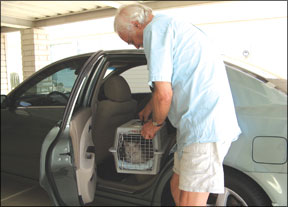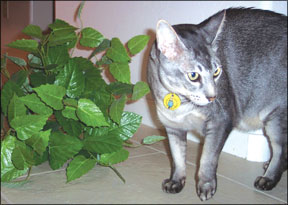Thinking about going on a leisurely week-long auto trip? Good for you! Thinking about taking your cat along for the ride? Youd better think twice about that, advises Julia Albright, MA, DVM, a resident of animal behavior at Cornell Universitys College of Veterinary

Bev Caldwell
288
Medicine. Theres a good chance, she maintains, that your pet would just as soon stay at home while you and the rest of your family pull out of the driveway.
“You might really want to take your cat along,” says Dr. Albright, “and thats totally understandable. But I would recommend that you leave the animal at home unless it has already shown that it likes to travel and wont get stressed out by the experience -and I havent met very many of those cats. In general, cats dont do very well with change, and traveling for hours on end in the back seat of a car would certainly come under the heading of change.”
For owners who cant bear the idea of putting their cats in a kennel for a week or so or leaving them at home in the care of a neighbor or professional pet sitter, Dr. Albright has some words of advice.
- Advance conditioning – “For most cats,” she says, “the only time theyll be in a carrier or a car is when theyre going to see the vet for their routine checkups and vaccinations. So they can have very strong aversive feelings about both the carrier and the car ride. I got into that awful crate and into that horrible car and I was manhandled and got stuck with something very sharp, and it hurt me.” To counter such unpleasant associations, Dr. Albright urges owners to “think ahead.”
“Get the carrier out several weeks before youre scheduled to start your trip,” she says. “Leave its door open and put a nice treat in the back of it, a piece of chicken or tuna, for example.” Within a few days, she notes, its likely that the cat will begin to move into and out of the carrier without apprehension. “If this doesnt work,” she adds, “it may help to buy a different type of carrier, one with which the cat has had no prior bad experiences.”
Once the cat seems to accept being confined within its carrier, the next step is to start putting the caged animal into your car and taking it for brief drives – maybe just a spin around the block – at least once a day. By rewarding the cat with treats during each outing, you will gradually promote its sense of comfort while traveling.
- Packing the necessaries – Well in advance of your departure, create a detailed checklist of the supplies that your cat will need while traveling, as well as those that will make its trip more enjoyable, such as familiar bedding, a special toy and its favorite treats. Topping the list, of course, will be an adequate supply of canned or dry food; food bowls; litter and a litter box – “the larger, the better,” says Dr. Albright – and an abundant supply of water. “You can always pick up bottled water while youre traveling,” she says, “but some cats may prefer the taste of the water that theyre in the habit of drinking at home.”
Other items on your checklist: cage liners; a scoop, paper towels and plastic bags for cleaning the litter box; soap for cleaning the food bowls; a can opener if youre taking canned food; all of the animals current medications; and an appropriate feline first-aid kit. (“At least take an antibiotic scrub or a tube of antibiotic ointment along,” says Dr. Albright, “in case the cat somehow gets scratched.”)
Be sure the cat wears a collar with an identification tag, even if it has an implanted microchip, she advises. In addition, she says: “Take your veterinarians phone number in case you have an emergency. You may also want to have the numbers of veterinarians along the way and at your destination. And be sure to have all of the cats vaccination certificates and medical records handy.”
- Safety measures – While on the road, fasten the carrier in place with a seat belt; if thats not possible, place the carrier on

Bev Caldwell
288
the floor of the car or in a secure area of the hatch. “Dont let an unharnessed cat out of its carrier while the car is in motion,” says Dr. Albright. “It might hop under the drivers feet, which would, of course, be very dangerous.” And unless your cat is harness-trained, you must never let it out of the car.
Every four to six hours, pull over, place the litter box on the back seat, and open the carrier so that the cat can get out and relieve itself if so inclined. Leave the windows open an inch or two or leave the air conditioning turned on to make sure that fresh air is constantly circulating inside the parked car.
If you plan on spending your nights at a motel, phone ahead to make sure that animals are allowed. When you arrive, Dr. Albright advises, keep the animal in its carrier until you are inside and the door is closed. And then confine it – along with its food and water bowls and litter box – in the bathroom or other separate, closed room while making sure the accommodations are cat-safe. Also be sure that any housekeepers know that you have a cat in the room; you dont want to take a chance with an opened door and a nervous cat.
All things considered – the painstaking preparations, the elaborate packing, the vigilance that must be practiced en route – Dr. Albright recommends leaving your cat at home with a qualified sitter instead of taking it along in the car. As she points out: “Its so much easier, the cat will be more comfortable, and it will be happy to see you when you return from your trip.”




